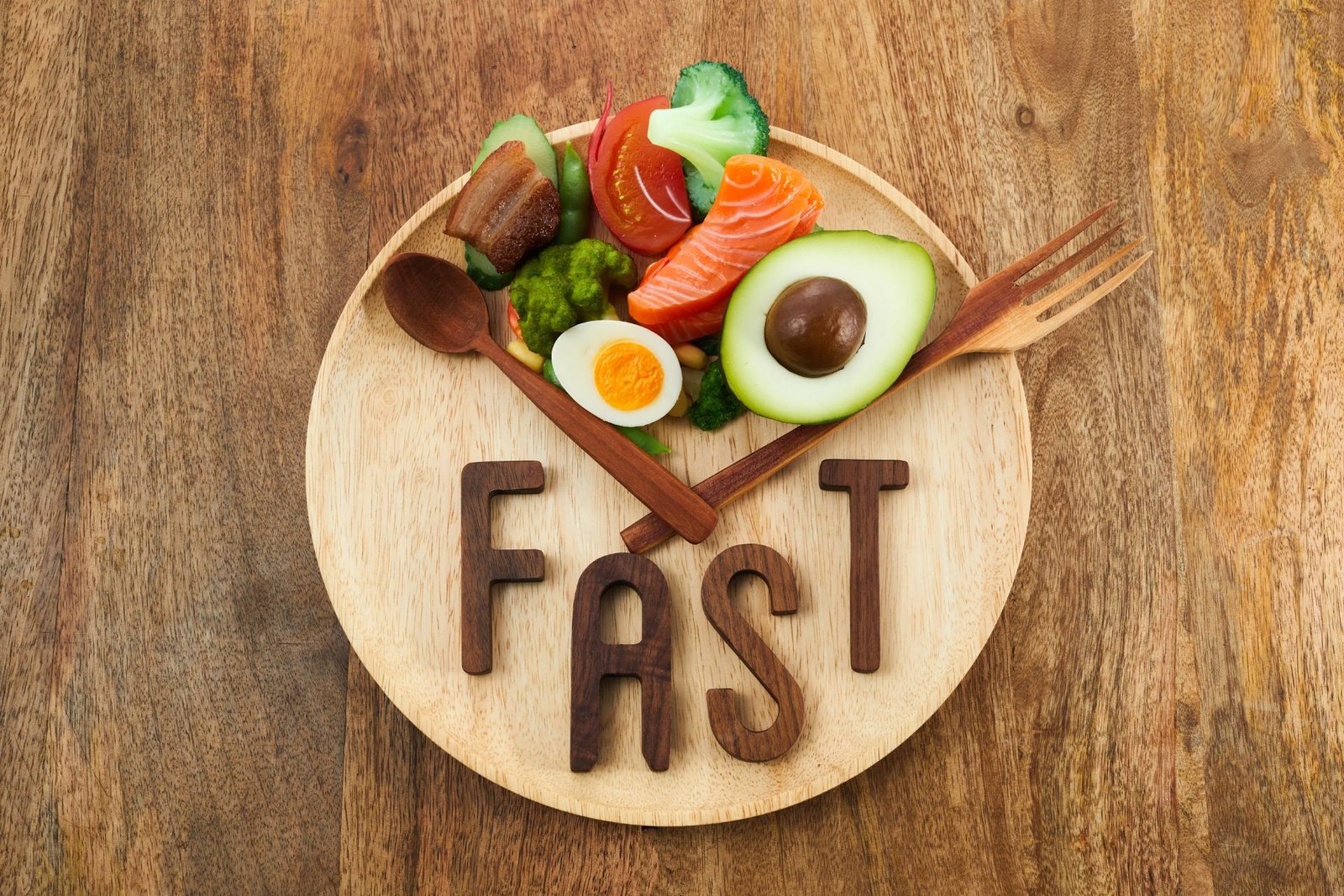This website may contain affiliate links. If you make a purchase through these links, I may earn a commission at no extra cost to you. Thank you for supporting this site.
Intermittent fasting 101: A popular trend in the health and wellness world, intermittent fasting has gained widespread attention for its potential benefits in weight management, metabolic health, and overall well-being. But what exactly is intermittent fasting, and how does it work?
Intermittent fasting, often abbreviated as IF, is not a diet in the traditional sense, but rather an eating pattern that alternates between periods of fasting and eating. The concept is simple: instead of focusing on what you eat, intermittent fasting focuses on when you eat.
There are several different methods of intermittent fasting, but the most common approach is the 16/8 method. This involves fasting for 16 hours each day and restricting your eating window to 8 hours. For example, you might choose to eat all of your meals between 12:00 pm and 8:00 pm, fasting for the remaining 16 hours.
Another popular method is the 5:2 diet, which involves eating normally for five days of the week and restricting calorie intake to around 500-600 calories on the remaining two days. Alternate day fasting involves alternating between days of regular eating and fasting, while the OMAD (One Meal a Day) approach entails consuming all of your daily calories in a single meal.
But how does intermittent fasting work? During the fasting periods, your body undergoes several physiological changes. In the absence of food, insulin levels drop, allowing your body to burn stored fat for energy. Additionally, fasting triggers autophagy, a process in which your cells remove damaged components and repair themselves. This can have profound effects on your overall health and longevity.
Intermittent fasting is not only about weight loss, although many people do experience significant reductions in body fat. It can also improve metabolic health by increasing insulin sensitivity and reducing inflammation. Some studies have even suggested that intermittent fasting may have anti-aging effects and could help protect against age-related diseases.
Getting started with intermittent fasting may seem daunting at first, but with the right approach, it can be both manageable and sustainable. Start by gradually increasing the length of your fasting periods and experiment with different fasting schedules to find what works best for you. It’s also important to stay hydrated and focus on eating nutrient-dense foods during your eating windows to ensure that you’re getting the essential nutrients your body needs.
In conclusion, intermittent fasting 101 is an introduction to a powerful tool for improving health and well-being. By incorporating intermittent fasting into your lifestyle, you can reap the benefits of weight loss, improved metabolic health, and potentially even increased longevity. With the right approach and mindset, intermittent fasting can be a sustainable and enjoyable way to achieve your health goals.
Table of Contents
Health Benefits of Intermittent Fasting
Intermittent fasting 101: Beyond its popularity as a weight loss strategy, intermittent fasting offers a plethora of health benefits that extend far beyond simply shedding pounds. Let’s explore some of the remarkable health benefits associated with intermittent fasting.
- Weight Loss and Management: Intermittent fasting is renowned for its effectiveness in promoting weight loss and facilitating weight management. By restricting the time window in which you consume food, intermittent fasting naturally reduces overall calorie intake, leading to a calorie deficit that can result in weight loss. Additionally, fasting periods prompt the body to tap into stored fat reserves for energy, further aiding in fat loss. Studies have shown that intermittent fasting can be as effective, if not more so, than traditional calorie-restricted diets for weight loss.
- Improved Metabolic Health: Intermittent fasting has been shown to have profound effects on various markers of metabolic health. It can improve insulin sensitivity, helping to regulate blood sugar levels and reduce the risk of type 2 diabetes. Fasting also promotes the production of human growth hormone (HGH), which plays a crucial role in metabolism, muscle growth, and fat burning. Additionally, intermittent fasting may help lower levels of inflammation in the body, which is linked to numerous chronic diseases.
- Potential Longevity Benefits: Studies in animals have suggested that intermittent fasting may extend lifespan and improve overall healthspan, or the number of years lived in good health. While more research is needed to confirm these findings in humans, intermittent fasting’s ability to enhance cellular repair mechanisms and protect against age-related diseases holds promise for promoting longevity and healthy aging.
- Impact on Insulin Sensitivity and Blood Sugar Levels: Intermittent fasting can significantly improve insulin sensitivity, making cells more responsive to insulin and enhancing the body’s ability to regulate blood sugar levels. This is particularly beneficial for individuals with insulin resistance or prediabetes, as it can help prevent the progression to type 2 diabetes. By reducing insulin resistance and lowering blood sugar levels, intermittent fasting may also reduce the risk of other metabolic disorders and cardiovascular diseases.
- Enhanced Cognitive Function: Emerging research suggests that intermittent fasting may have cognitive benefits as well. Fasting has been shown to stimulate the production of brain-derived neurotrophic factor (BDNF), a protein that promotes the growth of new neurons and protects existing ones. This could potentially lead to improvements in memory, learning, and overall cognitive function. Some studies have also suggested that intermittent fasting may help reduce the risk of neurodegenerative diseases like Alzheimer’s and Parkinson’s.
In summary, intermittent fasting 101 unveils a treasure trove of health benefits that extend far beyond weight loss. From improved metabolic health and enhanced insulin sensitivity to potential longevity benefits and cognitive enhancements, intermittent fasting offers a holistic approach to optimizing health and well-being. Incorporating intermittent fasting into your lifestyle may not only help you achieve your weight loss goals but also promote overall health and vitality for years to come.

Different Methods of Intermittent Fasting
Intermittent fasting 101: One of the key factors that make intermittent fasting so adaptable is the variety of methods it offers. From the popular 16/8 method to more flexible approaches like the 5:2 diet, there’s a fasting schedule to suit every lifestyle and preference. Let’s delve into the different methods of intermittent fasting and how they work.
- The 16/8 Method: Intermittent fasting 101 wouldn’t be complete without mentioning the 16/8 method, also known as the Leangains protocol. This method involves fasting for 16 hours each day and restricting your eating window to 8 hours. For example, you might choose to eat all of your meals between 12:00 pm and 8:00 pm, fasting for the remaining 16 hours. This method is popular because it’s relatively easy to implement and can be adjusted to fit your schedule.
- The 5:2 Diet: The 5:2 diet is another popular intermittent fasting approach. With this method, you eat normally for five days of the week and restrict calorie intake to around 500-600 calories on the remaining two days. These fasting days can be consecutive or non-consecutive, depending on your preference. The 5:2 diet offers flexibility and allows for a more relaxed approach to fasting, making it suitable for those who don’t want to fast every day.
- Alternate Day Fasting: Alternate day fasting involves alternating between days of regular eating and fasting. On fasting days, you typically consume around 25-50% of your normal calorie intake, while on non-fasting days, you eat as you normally would. This method can be more challenging for some people, as it requires stricter adherence to fasting days, but it can also offer more significant weight loss results for those who can stick to it.
- The OMAD (One Meal a Day) Approach: As the name suggests, the OMAD approach involves eating just one meal a day, typically within a one-hour window. This method is one of the most extreme forms of intermittent fasting and is not suitable for everyone. However, some people find it effective for weight loss and enjoy the simplicity of only having to plan and prepare one meal per day. It’s important to ensure that you’re still meeting your nutritional needs with this method, as eating only one meal a day can make it challenging to consume enough calories and nutrients.
- Extended Fasting: Extended fasting involves fasting for longer periods, typically ranging from 24 hours to several days. While not as commonly practiced as other forms of intermittent fasting, extended fasting can offer profound benefits for weight loss, metabolic health, and cellular repair. However, it’s essential to approach extended fasting with caution and consult with a healthcare professional before attempting it, especially if you have underlying health conditions.
In conclusion, intermittent fasting 101 introduces a variety of methods that allow for flexibility and customization to suit individual preferences and lifestyles. Whether you prefer the simplicity of the 16/8 method, the flexibility of the 5:2 diet, or the challenge of alternate day fasting, there’s a fasting schedule out there that can help you reap the benefits of intermittent fasting while fitting seamlessly into your daily routine.

How Intermittent Fasting Works
Intermittent fasting 101: Have you ever wondered how intermittent fasting actually works its magic on your body? Let’s dive into the science behind this popular eating pattern and explore the mechanisms that make it so effective.
At its core, intermittent fasting revolves around the concept of cycling between periods of eating and fasting. By restricting the time window in which you consume food, intermittent fasting prompts your body to undergo several physiological changes that can lead to numerous health benefits.
One of the primary ways intermittent fasting works is by regulating insulin levels. When you eat, especially foods high in carbohydrates, your body releases insulin to help transport glucose from the bloodstream into cells for energy. However, constantly elevated insulin levels can lead to insulin resistance and other metabolic issues.
During fasting periods, insulin levels drop, allowing your body to switch from using glucose as its primary source of energy to burning stored fat instead. This process, known as lipolysis, can lead to significant fat loss over time and is a key mechanism behind the weight loss benefits of intermittent fasting.
Intermittent fasting also triggers autophagy, a cellular repair process in which your body removes damaged or dysfunctional cells and recycles their components. This cleansing process helps rejuvenate cells and tissues, promoting overall health and longevity. Autophagy is particularly active during fasting periods when energy is scarce and the body needs to conserve resources.
Furthermore, intermittent fasting can stimulate the production of human growth hormone (HGH), a hormone that plays a crucial role in metabolism, muscle growth, and fat burning. Higher levels of HGH can help preserve lean muscle mass while promoting fat loss, making intermittent fasting an effective strategy for body composition changes.
Another way intermittent fasting works its magic is by promoting ketosis, a metabolic state in which your body produces ketones from stored fat to use as fuel. Ketosis typically occurs during prolonged fasting periods or when carbohydrate intake is severely restricted, such as in the case of the ketogenic diet. By inducing ketosis, intermittent fasting can further enhance fat burning and metabolic flexibility.
In summary, intermittent fasting 101 reveals that intermittent fasting works by harnessing the body’s natural metabolic processes to promote weight loss, cellular repair, and overall health. By cycling between periods of eating and fasting, intermittent fasting can regulate insulin levels, trigger autophagy, stimulate HGH production, and promote ketosis, leading to a wide range of health benefits. Whether you’re looking to lose weight, improve metabolic health, or enhance longevity, intermittent fasting offers a simple yet powerful approach to achieving your health and wellness goals.
Getting Started with Intermittent Fasting
Embarking on your intermittent fasting journey can seem daunting, but with the right approach, it can be a rewarding and sustainable way to improve your health and well-being. In this guide to intermittent fasting 101, we’ll walk you through the steps to get started with intermittent fasting and set yourself up for success.
- Assess Your Readiness: Before diving into intermittent fasting, take some time to assess your readiness and determine if it’s the right approach for you. Consider your current eating habits, lifestyle, and any health conditions you may have. Intermittent fasting is not suitable for everyone, so it’s essential to consult with a healthcare professional if you have any concerns or medical issues.
- Choose Your Fasting Schedule: Next, decide on the fasting schedule that best fits your lifestyle and preferences. Intermittent fasting offers various methods, including the 16/8 method, the 5:2 diet, alternate day fasting, and the OMAD approach. Experiment with different fasting schedules to find what works best for you and your schedule. Remember that consistency is key, so choose a fasting schedule that you can stick to in the long term.
- Start Gradually: If you’re new to intermittent fasting, it’s essential to start gradually and ease your way into it. Begin by gradually increasing the length of your fasting periods and gradually reducing the length of your eating window. This will give your body time to adjust to the new eating pattern and minimize potential side effects like hunger or fatigue. Aim to make small, sustainable changes rather than diving into fasting too quickly.
- Set Realistic Goals: When starting intermittent fasting, it’s essential to set realistic goals and expectations for yourself. While intermittent fasting can lead to significant weight loss and health improvements, it’s not a quick fix or a one-size-fits-all solution. Be patient with yourself and focus on making gradual progress over time. Set specific, achievable goals that align with your overall health and wellness objectives.
- Stay Hydrated: During fasting periods, it’s crucial to stay hydrated by drinking plenty of water. Water helps keep you feeling full and satisfied and can help mitigate feelings of hunger during fasting periods. Additionally, staying hydrated is essential for overall health and well-being, so be sure to drink an adequate amount of water throughout the day, especially during fasting periods.
- Focus on Nutrition: When it comes to intermittent fasting, quality matters just as much as quantity. While you may have more flexibility with your food choices during eating windows, it’s essential to focus on consuming nutrient-dense foods that nourish your body. Aim to include a balance of protein, healthy fats, fruits, vegetables, and whole grains in your meals to ensure you’re getting the essential nutrients your body needs.
In conclusion, intermittent fasting 101 is a simple yet powerful approach to improving your health and well-being. By assessing your readiness, choosing a fasting schedule, starting gradually, setting realistic goals, staying hydrated, and focusing on nutrition, you can set yourself up for success on your intermittent fasting journey. Remember that intermittent fasting is not a one-size-fits-all solution, so listen to your body and make adjustments as needed to find what works best for you. With patience, consistency, and dedication, intermittent fasting can become a sustainable and rewarding part of your healthy lifestyle.

Intermittent Fasting and Exercise
Integrating exercise into your intermittent fasting routine can amplify the benefits of both practices, leading to improved health, enhanced weight loss, and increased fitness levels. In this guide to intermittent fasting 101, we’ll explore how intermittent fasting and exercise can complement each other and offer tips for maximizing your workouts while fasting.
- Timing Your Workouts: When it comes to exercising while intermittent fasting, timing is key. Many people find success with scheduling their workouts during their eating windows, as this allows them to fuel their workouts with nutrients and replenish their energy stores afterward. However, some individuals prefer to exercise during fasting periods, as they may experience increased fat burning and metabolic benefits. Experiment with different timing strategies to find what works best for your body and schedule.
- Types of Exercise: The type of exercise you choose can also impact how you feel during fasting periods. While any form of physical activity can be beneficial, some types of exercise may be more suitable for fasting than others. Low to moderate-intensity activities like walking, yoga, or light resistance training are generally well-tolerated during fasting periods and can help maintain muscle mass while promoting fat loss. High-intensity workouts like sprinting or heavy weightlifting may be more challenging while fasting and may require additional fueling to perform optimally.
- Hydration and Electrolytes: It’s essential to stay hydrated before, during, and after exercise, especially while fasting. Drink plenty of water leading up to your workout and consider incorporating electrolytes, such as sodium and potassium, to help maintain hydration levels. Electrolyte-rich beverages like coconut water or electrolyte tablets can be particularly beneficial, especially if you’re exercising for an extended period or in hot conditions.
- Listen to Your Body: Pay attention to how your body responds to exercise while intermittent fasting and adjust your routine accordingly. If you feel weak, dizzy, or lightheaded during workouts, it may be a sign that you need to adjust your fasting schedule or fuel your workouts more effectively. Similarly, if you experience excessive fatigue or muscle soreness, it may be a sign that you need to dial back the intensity or duration of your workouts while fasting. Remember that everyone’s body is different, so listen to your body’s cues and make adjustments as needed.
- Post-Workout Nutrition: After completing your workout, refuel your body with a balanced meal or snack containing protein, carbohydrates, and healthy fats. This will help replenish glycogen stores, repair muscle tissue, and support recovery and muscle growth. Aim to consume your post-workout meal or snack within the first hour after exercise to maximize nutrient uptake and recovery.
In summary, intermittent fasting 101 highlights the potential synergies between intermittent fasting and exercise. By timing your workouts strategically, choosing appropriate types of exercise, staying hydrated, listening to your body, and prioritizing post-workout nutrition, you can maximize the benefits of both practices and optimize your health and fitness outcomes. Experiment with different strategies to find what works best for you, and remember to consult with a healthcare professional before making any significant changes to your exercise or fasting routine.

Nutrition and Meal Planning for Intermittent Fasting
Proper nutrition and meal planning are essential components of a successful intermittent fasting regimen. In this guide to intermittent fasting 101, we’ll explore how to optimize your eating habits during both fasting and eating windows to support your health and fitness goals.
- Fasting Period Nutrition: During fasting periods, it’s crucial to focus on staying hydrated and consuming non-caloric beverages like water, herbal tea, or black coffee. These beverages can help suppress hunger and keep you feeling satisfied until your next meal. Avoid consuming caloric beverages or snacks during fasting periods, as this can disrupt the fasting process and negate its benefits.
- Eating Window Nutrition: When it comes time to break your fast and eat your meals, focus on consuming nutrient-dense foods that provide essential vitamins, minerals, and macronutrients. Aim to include a balance of protein, healthy fats, fruits, vegetables, and whole grains in your meals to ensure you’re meeting your nutritional needs. Avoid processed foods, sugary snacks, and excessive amounts of refined carbohydrates, as these can lead to energy crashes and cravings later on.
- Meal Timing and Composition: Intermittent fasting allows for flexibility in meal timing and composition, but it’s essential to pay attention to when and what you eat during your eating windows. Many people find success with starting their day with a balanced breakfast to kickstart their metabolism and provide sustained energy throughout the day. Others prefer to consume larger meals later in the day or practice the OMAD (One Meal a Day) approach, where they eat all of their daily calories in a single meal. Experiment with different meal timing and compositions to find what works best for your body and schedule.
- Meal Prep and Planning: Planning ahead can make sticking to your intermittent fasting routine much easier. Consider meal prepping and batch cooking your meals ahead of time to ensure you have healthy options available during your eating windows. This can help prevent impulsive food choices and save time during busy days. Additionally, make sure to stock your kitchen with nutrient-dense foods and snacks that align with your dietary preferences and goals.
- Hydration and Supplements: In addition to focusing on food choices, it’s essential to prioritize hydration and consider supplementing as needed. Drink plenty of water throughout the day, especially during fasting periods, to stay hydrated and support overall health. Additionally, consider incorporating supplements like multivitamins, omega-3 fatty acids, or electrolytes to fill any nutritional gaps and support optimal health and well-being.
In summary, intermittent fasting 101 emphasizes the importance of nutrition and meal planning in supporting your intermittent fasting journey. By focusing on nutrient-dense foods, meal timing and composition, meal prep and planning, hydration, and supplementation, you can optimize your eating habits to align with your intermittent fasting goals and promote overall health and well-being. Experiment with different strategies to find what works best for you, and remember to listen to your body’s cues and adjust your approach as needed.

Overcoming Challenges and Side Effects
While intermittent fasting can offer numerous health benefits, it’s not without its challenges and potential side effects. In this guide to intermittent fasting 101, we’ll explore some common obstacles that individuals may encounter when starting an intermittent fasting regimen and offer strategies for overcoming them.
- Hunger and Cravings: One of the most common challenges of intermittent fasting is dealing with hunger and cravings, especially during fasting periods. To combat this, it’s essential to stay hydrated and consume non-caloric beverages like water, herbal tea, or black coffee to help suppress appetite. Additionally, keeping busy with activities or distractions can help take your mind off food cravings. Over time, many people find that hunger and cravings diminish as their bodies adapt to the fasting schedule.
- Fatigue and Lightheadedness: Some individuals may experience feelings of fatigue or lightheadedness, especially when first starting intermittent fasting. This can be due to fluctuations in blood sugar levels or dehydration. To prevent fatigue and lightheadedness, make sure to stay hydrated by drinking plenty of water throughout the day, especially during fasting periods. Consuming electrolytes or incorporating salt into your meals can also help maintain hydration and support energy levels.
- Irritability and Mood Swings: Intermittent fasting can sometimes impact mood and emotions, leading to irritability or mood swings, particularly during fasting periods. To mitigate this, focus on practicing self-care and stress management techniques like meditation, deep breathing exercises, or gentle exercise. Ensuring you’re getting enough sleep and prioritizing relaxation can also help stabilize mood and emotions during intermittent fasting.
- Digestive Issues: Some individuals may experience digestive issues like bloating, gas, or constipation when starting intermittent fasting. This can be due to changes in eating patterns or the types of foods consumed during eating windows. To alleviate digestive discomfort, focus on eating fiber-rich foods like fruits, vegetables, and whole grains during eating windows, and avoid overeating or consuming large meals too quickly. Additionally, staying hydrated and incorporating probiotic-rich foods like yogurt or kefir can help support digestive health.
- Difficulty with Social Situations: Participating in social events or gatherings can present challenges for individuals following an intermittent fasting regimen. To navigate social situations while fasting, consider planning ahead and communicating your dietary preferences or restrictions with friends and family. Focus on enjoying the social aspect of gatherings rather than solely focusing on food, and look for alternative activities or ways to participate that don’t revolve around eating.
In summary, intermittent fasting 101 acknowledges that overcoming challenges and side effects is an essential aspect of starting and maintaining an intermittent fasting routine. By implementing strategies to address hunger and cravings, fatigue and lightheadedness, irritability and mood swings, digestive issues, and difficulty with social situations, you can increase your chances of success and optimize your intermittent fasting experience. Remember to listen to your body’s cues and make adjustments as needed to ensure a positive and sustainable intermittent fasting journey.

Intermittent Fasting for Specific Goals
Intermittent fasting 101: While intermittent fasting is often associated with weight loss, it can be a versatile tool for achieving a variety of health and fitness goals. In this guide, we’ll explore how intermittent fasting can be tailored to specific objectives, including weight loss, muscle gain, and improved energy and focus.
- Intermittent Fasting for Weight Loss: Intermittent fasting is perhaps best known for its effectiveness in promoting weight loss. By creating a calorie deficit during fasting periods, intermittent fasting can lead to fat loss while preserving lean muscle mass. Additionally, intermittent fasting can improve metabolic health by increasing insulin sensitivity and reducing inflammation, making it an effective strategy for long-term weight management.
- Intermittent Fasting for Muscle Gain: Contrary to popular belief, intermittent fasting can also be compatible with muscle gain goals. While fasting periods may increase protein breakdown, studies have shown that overall protein synthesis rates remain stable or may even increase during intermittent fasting. By consuming adequate protein and calories during eating windows and incorporating resistance training into your routine, you can support muscle growth and development while intermittent fasting.
- Intermittent Fasting for Improved Energy and Focus: Many people report increased energy and mental clarity when following an intermittent fasting regimen. Fasting periods can promote the production of ketones, which are an alternative fuel source for the brain and body. This can lead to improved cognitive function, enhanced focus, and sustained energy levels throughout the day. Additionally, intermittent fasting can help regulate blood sugar levels, reducing energy crashes and promoting stable energy levels.
- Intermittent Fasting for Metabolic Health: Intermittent fasting has been shown to have numerous benefits for metabolic health, including improved insulin sensitivity, reduced inflammation, and lower levels of oxidative stress. These effects can help lower the risk of type 2 diabetes, cardiovascular disease, and other metabolic disorders. By incorporating intermittent fasting into your lifestyle, you can support overall metabolic health and reduce the risk of chronic disease.
- Intermittent Fasting for Longevity: Emerging research suggests that intermittent fasting may have anti-aging effects and could help promote longevity. By activating cellular repair mechanisms like autophagy and reducing oxidative stress, intermittent fasting may help slow down the aging process and extend lifespan. While more research is needed to fully understand the long-term effects of intermittent fasting on longevity, early studies are promising.
In summary, intermittent fasting 101 demonstrates that intermittent fasting can be customized to specific goals, including weight loss, muscle gain, improved energy and focus, metabolic health, and longevity. By tailoring your fasting regimen to align with your objectives and incorporating other healthy lifestyle habits like regular exercise and balanced nutrition, you can maximize the benefits of intermittent fasting and achieve your health and fitness goals.

Safety Considerations and Precautions
Intermittent fasting 101: While intermittent fasting can offer numerous health benefits, it’s essential to approach it with caution and consideration for your individual health needs. In this guide, we’ll explore some safety considerations and precautions to keep in mind when starting an intermittent fasting regimen.
- Consult with a Healthcare Professional: Before starting intermittent fasting, it’s crucial to consult with a healthcare professional, especially if you have any underlying health conditions or concerns. Your healthcare provider can assess your medical history, current health status, and medications to determine if intermittent fasting is safe and appropriate for you. They can also provide guidance on how to adjust your fasting schedule or dietary approach to accommodate any specific health needs.
- Monitor for Signs of Negative Effects: Pay attention to how your body responds to intermittent fasting and be on the lookout for any signs of negative effects. These may include excessive hunger, fatigue, lightheadedness, irritability, or changes in mood or energy levels. If you experience any concerning symptoms while intermittent fasting, it’s essential to listen to your body and consider adjusting your fasting schedule or seeking guidance from a healthcare professional.
- Stay Hydrated: Adequate hydration is crucial during intermittent fasting, as fasting periods can increase the risk of dehydration. Make sure to drink plenty of water throughout the day, especially during fasting periods, to stay hydrated and support overall health and well-being. Consider incorporating electrolytes or electrolyte-rich beverages like coconut water to help maintain hydration levels, particularly if you’re exercising or sweating heavily.
- Avoid Extreme Fasting Practices: While intermittent fasting can be an effective tool for improving health and well-being, it’s essential to avoid extreme fasting practices that may pose risks to your health. This includes prolonged fasting periods lasting more than 24-48 hours or fasting methods that severely restrict calorie intake or nutrient intake. Extreme fasting practices can lead to nutrient deficiencies, electrolyte imbalances, muscle loss, and other adverse effects.
- Listen to Your Body: Intermittent fasting is not a one-size-fits-all approach, and what works for one person may not work for another. It’s essential to listen to your body’s cues and adjust your fasting regimen accordingly. If you experience persistent hunger, fatigue, or other negative effects, consider modifying your fasting schedule, duration, or approach to better suit your individual needs and preferences.
- Focus on Balanced Nutrition: While intermittent fasting can offer flexibility in meal timing, it’s crucial to prioritize balanced nutrition during eating windows. Focus on consuming nutrient-dense foods that provide essential vitamins, minerals, and macronutrients to support overall health and well-being. Avoid relying on processed foods, sugary snacks, or excessive amounts of refined carbohydrates, as these can negatively impact your health and energy levels.
In summary, intermittent fasting 101 emphasizes the importance of safety considerations and precautions when starting an intermittent fasting regimen. By consulting with a healthcare professional, monitoring for signs of negative effects, staying hydrated, avoiding extreme fasting practices, listening to your body, and focusing on balanced nutrition, you can minimize potential risks and maximize the benefits of intermittent fasting for your health and well-being.

Conclusion
In conclusion, intermittent fasting is a powerful tool for improving health, promoting weight loss, and achieving various fitness goals. By alternating between periods of fasting and eating, intermittent fasting can harness the body’s natural metabolic processes to optimize health and well-being.
Throughout this guide to intermittent fasting 101, we’ve explored the fundamentals of intermittent fasting, including its various methods, health benefits, and strategies for getting started. We’ve also discussed safety considerations and precautions to keep in mind when incorporating intermittent fasting into your lifestyle.
While intermittent fasting can offer numerous benefits, it’s essential to approach it with caution and consideration for your individual health needs. Consulting with a healthcare professional, monitoring for signs of negative effects, staying hydrated, avoiding extreme fasting practices, and listening to your body are all essential aspects of practicing intermittent fasting safely and effectively.
Ultimately, intermittent fasting is not a one-size-fits-all approach, and what works for one person may not work for another. It’s essential to experiment with different fasting schedules, methods, and approaches to find what works best for your body and lifestyle.
Whether your goal is weight loss, muscle gain, improved energy and focus, or overall health and longevity, intermittent fasting can be customized to suit your objectives. By incorporating intermittent fasting into your lifestyle alongside other healthy habits like regular exercise, balanced nutrition, and adequate sleep, you can maximize the benefits of intermittent fasting and achieve your health and fitness goals.
Remember that intermittent fasting is a journey, and it’s okay to make adjustments along the way. Stay patient, stay consistent, and stay focused on your goals. With dedication and perseverance, intermittent fasting can become a sustainable and rewarding part of your healthy lifestyle.



